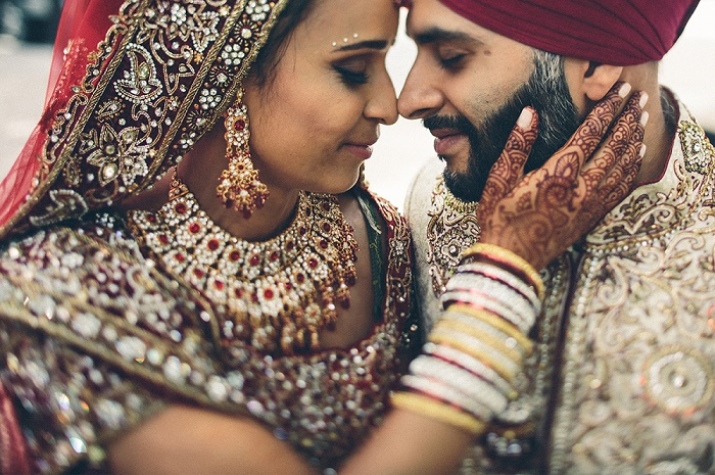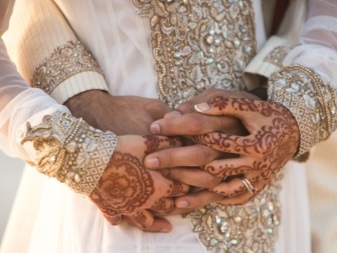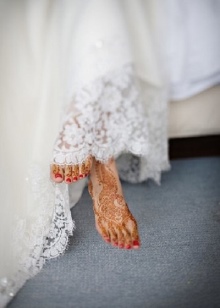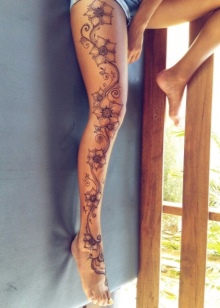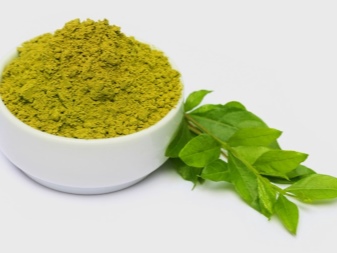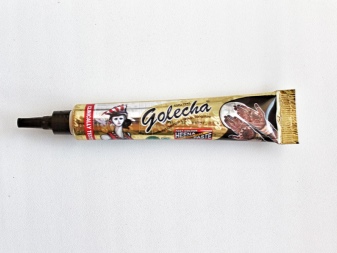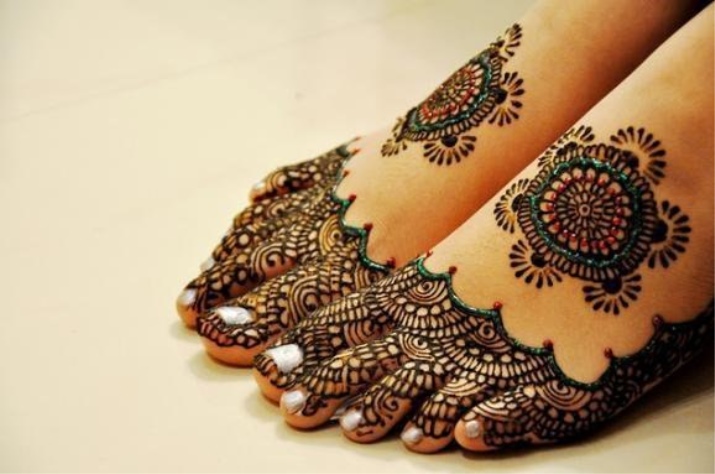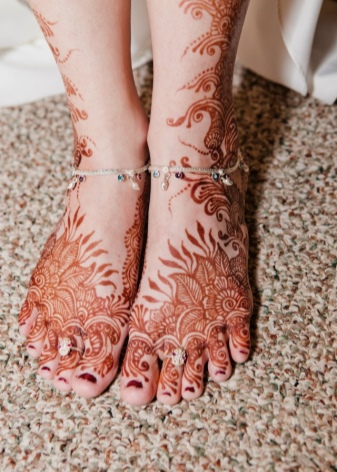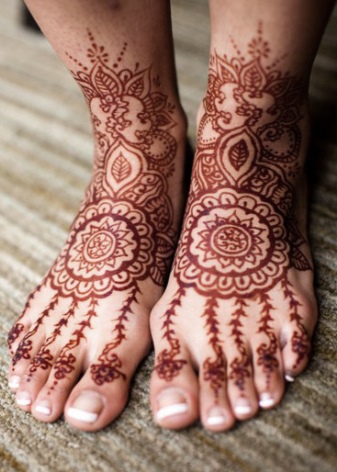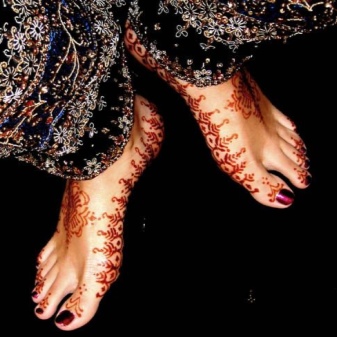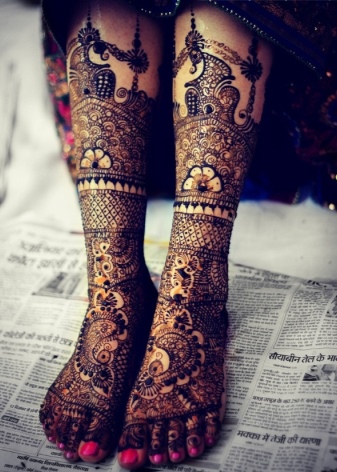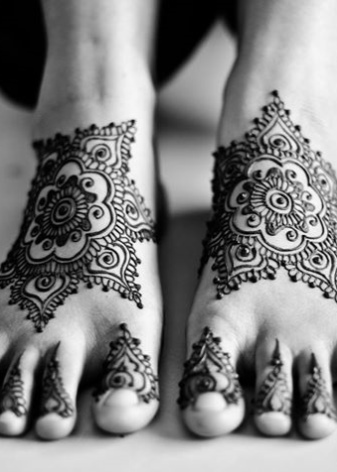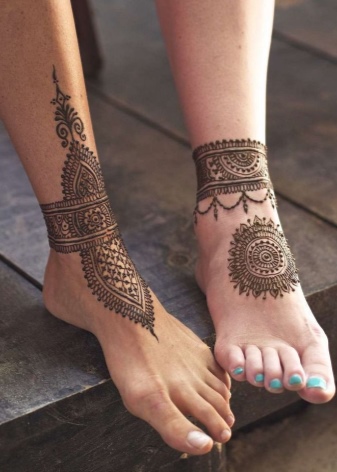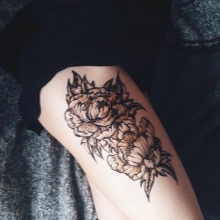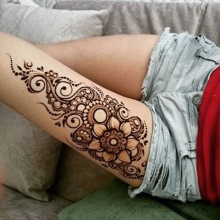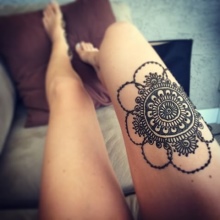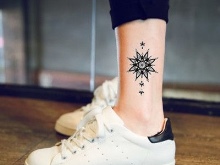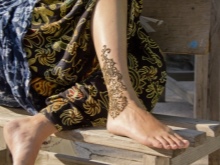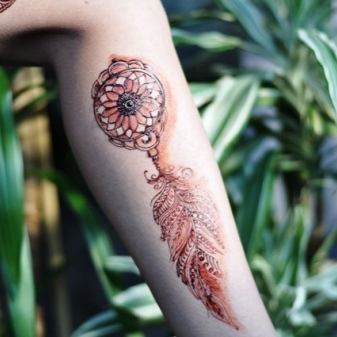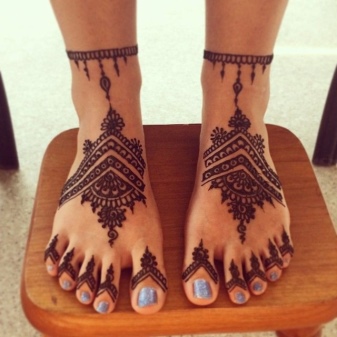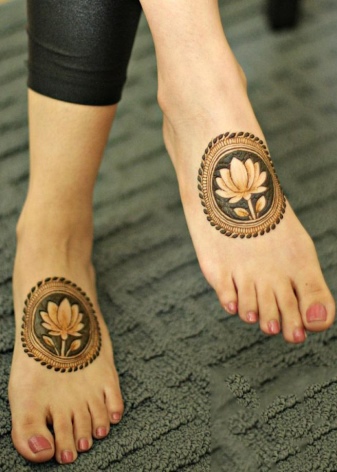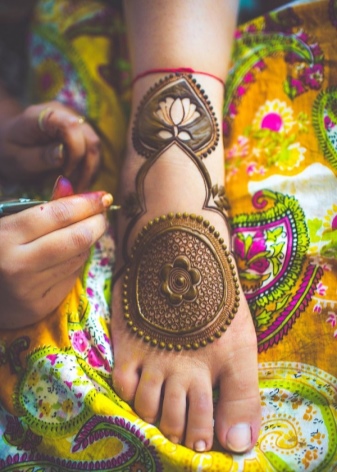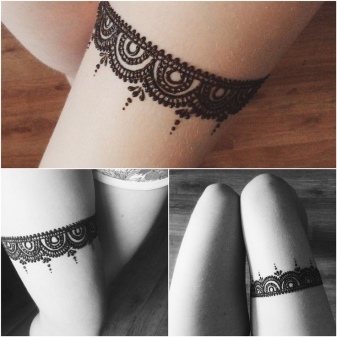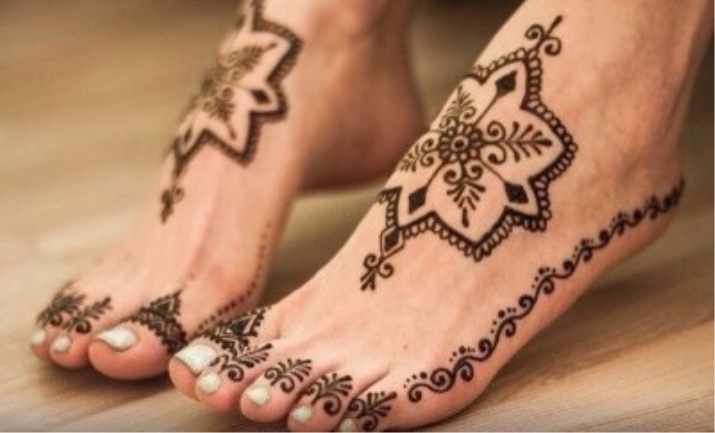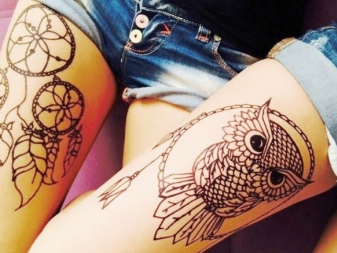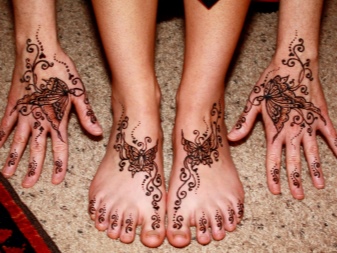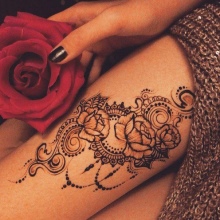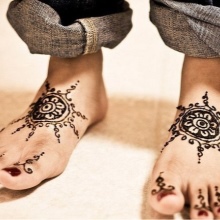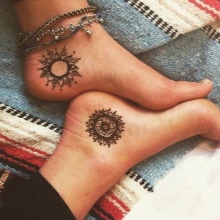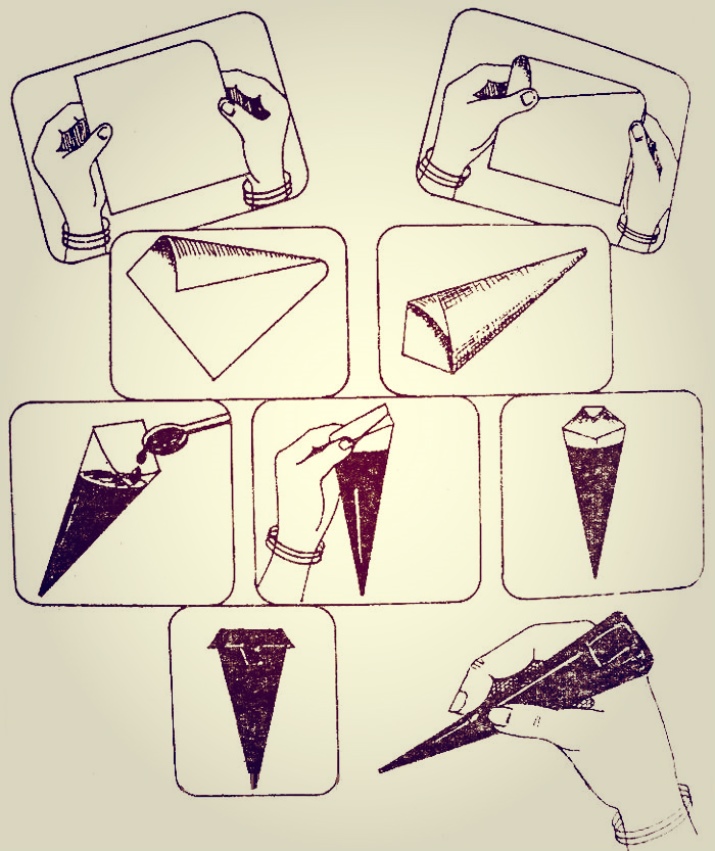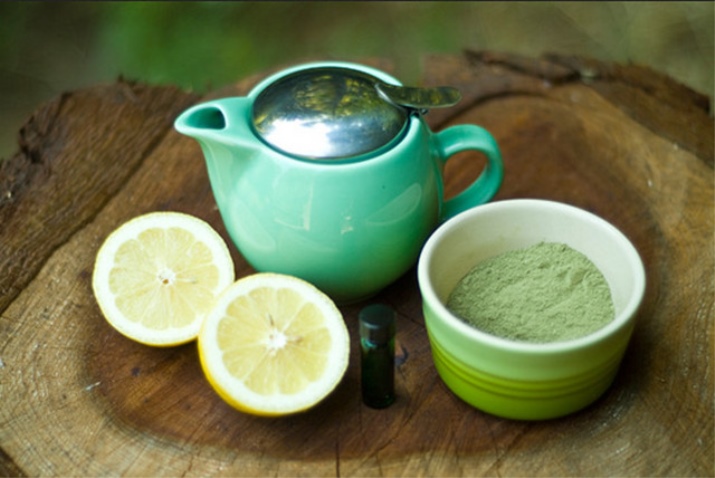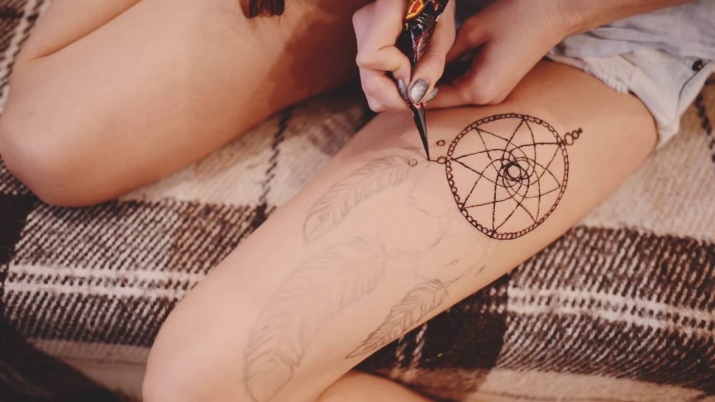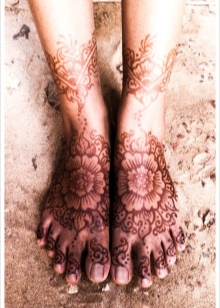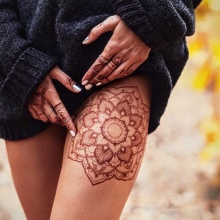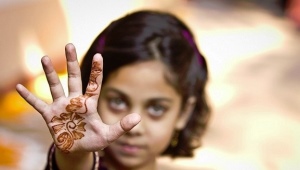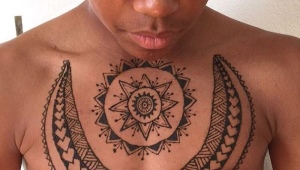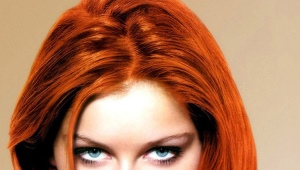Henna Drawings on the Leg
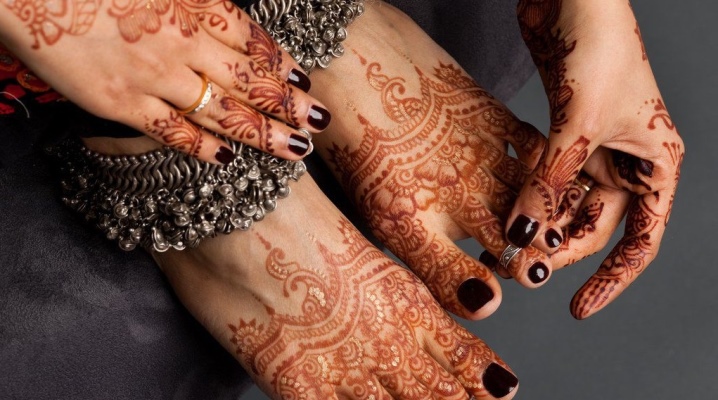
The beach period and the season of wearing open clothes become an excellent reason to decorate your body. Henna drawing is a great way to get attention. The substance is completely safe for the skin. Many who are not ready for real tattoos, choose just such drawings. This tradition has come to us from Eastern countries and is very popular.
What is mehendi?
Mehendi (Mehndi) - traditional Indian body painting using henna paste. Often these drawings are called temporary tattoos, because the image completely comes off the skin in 2-3 weeks. Reliably track the origin of such art is difficult. Today, it is considered that mehendi is from Arab countries. Temporary henna tattoos are widely used in European countries.
Mehndi appeared 5,000 years ago in ancient Egypt. Only noble ladies could afford henna body decoration. Body painting is closely intertwined with tradition. Indian women are confident that the images attract good luck and protect against trouble. Based on this, there is a tradition of painting the body of the bride before the wedding.
In different eastern countries, mehendi have their own characteristics. So, in the Middle East you will find floral patterns. In India, it is customary to apply lace patterns, symbols of fertility and religious motifs. Indonesia also pays tribute to plants. There is a complete painting of parts of the body (pad of the fingers, feet, etc.). But in Malaysia, painting is allowed only on the eve of the wedding.
In our country, girls increasingly prefer painting on the body with henna due to its aesthetic appeal. Many are attracted by the fact that the picture completely disappears from the skin. Henna can be applied in different ways, many techniques are easy to do at home. For more complex images, you should contact the master.
Henna pattern can hold on your skin for an average of 10-14 days. Sometimes this figure reaches 21-30 days.
It depends on many factors. If you have oily skin, the pattern will come down faster. Much depends on how often you wet the drawing. Remember that frequent application of pigment accelerates the aging process of the skin.
If the drawing did not work for you or you need to remove it for some reason, it will be difficult. Henna can not just be washed off, but there are some tips that will help you. To begin with, thoroughly steam the place of the drawing and wash it thoroughly with a washcloth. You can use a scrub instead of a sponge. So you can remove the top layer of the epidermis, which contains pigment.
How to choose henna?
Henna for mehendi is sold in two forms: powder and paste. Pasta is great for beginners, with powder work harder. To use a dry product you need to know exactly the rules of breeding, the necessary components and their proportions. Spread is often sold in cones. To use it is enough just to carefully cut off the tip and extrude the tool.
When choosing a material, it is important to understand its composition and origin. Henna for Mehndi is of two types:
- Natural. Such a natural dye is obtained from the leaves of cinchona tree. The color of the natural product is brown. If you buy pasta in a cone, then pay attention to its appearance. If you notice that the packaging was blown away or deformed, then inside is a poor-quality product. In addition, the packaging must be carefully sealed, without holes. This is due to the fact that the product may frost. The paste itself has a fluid and soft structure.
- Colored henna. This product is manufactured using chemical additives. Often sold in tubes or cans.Thanks to chemical dyes, henna can be of any color. Carefully examine the composition before purchase to ensure that there are no allergens. Choose materials that are dominated by natural ingredients. The pattern of such henna resembles a real color tattoo.
Even novice masters understand that the quality of future creation directly depends on the right material.
Henna freshness and color saturation are fundamental. From the freshness of the material depends on its ability to color the skin. You can not be sure that the seller has complied with the rules of storage of the material, but you can definitely check the expiration dates before purchase.
Natural henna is suitable for 1 year. However, a truly good shade can be obtained only in the first 3 months if the rules of storage are observed, then the color will fade. That is why it is important to ask the seller is not the shelf life, and the date of manufacture. If there is an opportunity to explore the box with the goods - use it.
Good quality henna can be distinguished by the following signs:
- The cone is plump, impossible to push through with your fingers.
- After opening the package you see a fluid and soft paste.
- Henna voluntarily follows from the packaging after opening.
All these recommendations for freshness refer to natural henna. Black and colored incorporates chemical elements, therefore retains freshness longer. Color staining depends on the initial skin tone. Natural brown dye on light skin can become orange. Consider these nuances when choosing materials.
Drawing styles
Before applying the image is to determine the style. You can choose a modern pattern or understand more ancient motives. Mehendi has existed for many hundreds of years, and during this time certain styles have been formed:
- Arab. Such drawings are reminiscent of oriental painting, they have many floral components. Arabic Mehndi has no special rules of application and color saturation. There is only one condition: the drawing should look elegant and rich.
- African. Here you will find many clear stripes and regular figures. Such a henna tattoo on his feet has a special requirement: the outlines of the image must completely coincide with the lines of the feet.
- Indian. Such drawings are the most difficult to implement. Here you will find many possible elements: plants, figures, animals. Moreover, each component of the image carries a special meaning, nothing is depicted just like that. Patterns in this style occupy a lot of space on the body. Often they imitate gloves, stockings or bracelets.
- Asian. Indian and Arab traditions are intertwined in this direction. There is a characteristic feature - fingertips should be painted over completely.
- European. This direction is considered the youngest of all. It is in the European style that all of the above are intertwined. Here you will not find special meanings, secret traditions or strict rules. The choice of drawing depends solely on your preferences. This modern trend is very attractive for young people and provides an excellent field for imagination.
Many believe that only women tend to decorate their bodies with henna, but this is a delusion. Men too often resort to this method of applying temporary tattoos. However, most often it is practical. For example, the Bedouins live in the deserts of Africa, they use henna to lower the temperature of their feet. For this, men simply dip their feet into henna paste.
The value of the location of the picture
Since mendi is a special culture, part of the tradition, the drawings have special meanings. The choice of the location of the image is also not chosen randomly. Arab countries and India firmly believe in the mystical meaning of mehendi. Picture Location:
- Right leg.
The person with the image on this leg is in the eternal search for himself and his I. Thus, the desire is expressed to draw the attention of others to their principles and life values, goals.
- Left leg.
Drawing on the thigh or on the calf of the left leg says that the holder of the picture knows exactly which way to go through life in order to achieve the desired goal.
- Right foot.
The person with this image is rather selfish and does not hide it. The owner is not happy with his friends and acquaintances, he is not satisfied with the circle of persons with whom he is forced to maintain contact.
- Left foot.
The owner lacks support from the closest circle. Since the family does not satisfy the psychological need, the person is in search of a reliable life partner, who will become a support.
- Shin or ankle.
These zones do not have their own mystical significance. The interpretation of the pattern on the shin or ankle directly depends on the chosen ornaments, color and saturation of the pattern.
What do the patterns mean?
The mystical significance of henna tattoos is not limited to location. The image itself plays a big role. Specialists in this field have collected the most common images and deciphered their meaning. Here is what you need to know before applying the picture:
- Dreamcatcher on the side of the ankle.
Such a sign itself is the strongest talisman. He is able to protect his owner from restless nightmares, insomnia. The essence of the talisman - it is in the protection of the carrier during the holidays. It is important that the cobweb in the center of the dreamcatcher has 8 intersections, since This is a symbolic designation of a spider.
- Feather anywhere on the feet.
This pattern is quite meaningful and versatile. This image can emphasize your own cheerfulness, courage, patience, a tendency to wisdom and substandard thinking. Such a symbol is peculiar to creative individuals who do not recognize the existence of frameworks and conventions.
- Anklet Bracelet.
Such mehendi will become a true aesthetic pleasure for connoisseurs. Such drawings can be quite simple or, on the contrary, have a lot of clever details. The bracelet is depicted in order to draw attention to its successes and achievements in any area of life.
- Lotus.
In eastern countries, the lotus is equal to the holy image. This Mehndi often draw on the foot. The value may vary depending on the complexity of the image and the number of petals. These flowers symbolize the feminine principle, wisdom and sexuality. Such a pattern on the body will bring with it a lot of positive and bright changes.
- Mehendi garter.
This image is typical for bold and uninhibited girls. Imitation gum stocking or garter is a strong sexual signal and informs others that the owner of the picture is ready for a vivid adventure.
- Asterisks.
Such a symbol suggests that a person seeks harmony within himself.
- Rhombus.
A girl who wears such an image wants to tell everyone about her emotionality, sensuality and susceptibility.
- Triangle.
The one who wears such a geometrical figure on his leg is precisely defined with his goal and takes steps to achieve it.
- Panther.
This wild cat is usually located on the ankle or ankle. Panther personifies a strong and tough character, grace, leadership instincts, a tendency to respond quickly.
- Cat.
Such an image often causes tenderness and a smile, but only for those who do not know the true meaning of this symbol. Such a picture on the female body speaks of cunning and inclination to deception. There is another meaning of a cat. Often the symbol informs others that the owner seeks personal independence and freedom.
- Peacock.
Such an image is often applied to the side of the calf. The bird symbolizes greatness and beauty, fortitude. Often, girls emphasize the romance of their nature with the help of such a picture.There is evidence that a peacock is able to attract happiness and glory to its owner.
- Butterfly.
In eastern culture, it is considered that just as a butterfly is able to transform from a caterpillar, so a character's owner is reborn.
- Owl.
Girls often depict an owl on the thighs or feet, but men - on the calves and knees. The value of the owl is multifaceted, but the location significantly narrows the circle of interpretations. Owl on foot is a challenge to others. The owner reports that he does not believe in the loyalty and friendship of those who are nearby.
- The Rose.
A fairly common image for mehendi. Most often, the rose symbolizes virginity and purity. The abundance of flower buds in the figure symbolizes loving and the beginning of a new life. Composition with buds and leaves means abundance and prosperity.
- The sun.
This drawing symbolizes the meaning of life, its energy and warmth. It was previously believed that the sun is a divine symbol. This image is able to awaken the forces within you and provide a surge of positive emotions.
Application technique
The advantage of henna tattoos is that they can be performed independently at home. Learning technology is quite simple. The only thing important is to stick with technology. First you need to properly cook henna paste. Here are the basic rules of preparation:
- Approximately one day prior to the application of the picture, discard the tanning bed and any other exposure to ultraviolet rays.
- It is possible to apply drawing on one place no more than 2 times in a month. Experts say that our skin needs rest even from natural pigments.
- Do not apply moisturizers on the area of skin where you are going to apply henna tattoo. On the contrary, wash the area with soap and wipe with an alcohol solution. So you remove excess fat from the skin. If the skin is peeling or bumps, then be sure to treat the area with a scrub.
- Remove hair from the place of the future drawing. The reason is that henna can dye not only the skin, but also the hair. In the hair scales, the pigment will remain for a longer time. When the image is completely gone from the skin, you will have colored hairs.
Ready-made henna paste is sold in cones. The same can be made independently of dense foil or paper. To do this, simply roll the material into a cone and secure the edges with adhesive tape. In a pointed place, make a hole with a wide needle. Experts say that using a cone is convenient and is the best option for beginners.
If you purchased henna powder, you will need to prepare the mixture yourself. Pasta must be prepared in advance. The process of preparing the mixture in stages:
- Make strong tea (3 tsp. Of tea for 0.5 l of water).
- Boil it for 5-10 minutes on low heat.
- Strain.
- Slowly pour the tea into 40 g of henna powder. Stir the mixture continuously to avoid lumps.
- In the solution, add 2-3 drops of mehendi or eucalyptus oil and 2 spoons of lemon juice.
- As a result, you have a mixture that resembles toothpaste by consistency. Put it in the fridge for 4 hours.
This paste can be stored in a sealed package for up to 3 weeks or frozen for up to 4 months. There are more simple cooking methods. You can mix an equal amount of tea and lemon juice, add the necessary amount of henna there. Tea can be replaced by coffee. Some experts add sugar to increase viscosity. It is recommended to test several ways and choose the one that suits you.
Simple drawings on the foot can be applied even if there are no special drawing skills. You can use ready-made sketches and even stencils. Drawing drawing:
- Test for henna sensitivity. To do this, apply a small amount of paste on the elbow bend and wait 30-40 minutes. If skin reactions do not, then you can carry out the procedure of applying mehendi.
- Wash the area thoroughly for future soap and water patterns. If necessary, apply a scrub.
- Remove hair from the drawing area.
- Treat the skin with eucalyptus oil or a special oil for mehndi.
- Now go directly to the drawing pattern. To get started, hover the main lines of the kupny. Only after that draw small elements.
- The layer of paste on the skin should be 2 or more millimeters.
- Errors during drawing can be removed immediately with a cotton swab.
- After applying the image, leave the paste on the skin for 1 hour.
- Remove the dry crust from the skin using a special scraper or the blunt side of the knife.
- Follow mehndi for the night, because the image can not be wet for the next 8 hours.
Fashion ideas
In many countries, old mehendi styles are used. Drawings are perceived as talismans, amulets. That is why the patterns are traditional. Many girls prefer stylized images and adhere to the rules. Modern girls often put pictures not for protection, but for decorating the body.
Mehendi is often used to try out a drawing in a certain place before making a regular tattoo. Most of these images can be attributed to the European style Mehndi. It enjoys its popularity due to its diversity, availability, and optimal wear life. You can experiment often, until you find something of your own.
Small pictures look great on the body. On the foot you can draw an animal or a small bird. So you emphasize your features, but do not attract too much attention. Often the composition is based on the image of hearts, birds, animals and plants.
A variety of options for fashionable tattoo for girls is amazing. Girls prefer bracelets, ornaments, dream catchers with feathers and flowers. If you study men's preferences, then among them there are inscriptions, wild animals and a variety of characters. Fashion is capricious, but mehendi is always in trend.
Simple drawings can be applied independently. Ready sketches will help you make the right choice. Lightweight bracelets with feathers look great on girl ankles. Plant and flower motifs can emphasize the elegance of the legs. Especially if they twist the leg around. To get started, try out the traditional drawings. Experiment with beautiful motifs of nature or lace.
How to draw a mehendi on the foot - in the next video
